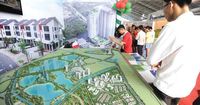In 2024, the real estate landscape in Vietnam, particularly in Hanoi's satellite cities, witnessed a significant shift as more individuals sought sustainable living options. This trend has led to a notable increase in the movement of population and investment in green real estate, with data from Batdongsan.com.vn highlighting a surge in interest in provinces such as Bac Ninh, Hung Yen, Vinh Phuc, Ha Nam, and Hoa Binh.
According to the platform, interest in Vinh Phuc's real estate rose by 42% compared to the first quarter of 2023, while Hung Yen saw an impressive 111% increase. In contrast, Hanoi itself experienced a slight decline in interest, dropping by 7%. This trend of migration towards satellite cities is part of a broader movement known as "Hanoi expansion," which has been ongoing since 2008.
Many major investors have capitalized on this trend by developing key projects that enhance the real estate supply in these areas. Notable urban developments such as Ecopark, Vinhomes Riverside, Vinhomes Ocean Park, and Gamuda Gardens have emerged, attracting a significant number of residents. Over the past eight years, property prices in these regions have skyrocketed, increasing by two to four times.
Mr. Bach Duong, General Director of Batdongsan.com.vn, attributes this trend to the capital's planning that emphasizes regional development and connectivity with neighboring provinces. The development of infrastructure, including Beltways 2 and 3, highways, and metro lines, has made these satellite cities more accessible. The rising property prices in Hanoi, driven by a scarcity of land, along with high population density and severe air pollution in the city, have further fueled interest in these areas.
Looking ahead to 2025 and 2026, the satellite real estate market is expected to welcome numerous new urban projects. Major developers are focusing on areas surrounding the capital, with projects like Thanh Xuan Valley (BIM Land), Sun Urban City (Sun Group), and Vinhomes Global Gate (Vinhomes) set to launch. Provinces like Vinh Phuc, Hung Yen, and Ha Nam are emerging as attractive destinations due to their ample land, improving transportation infrastructure, and policies promoting sustainable urban development.
Interestingly, a recent Q4 2024 report from Batdongsan.com.vn revealed that 86% of surveyed Vietnamese expressed interest in green real estate, with 94% willing to pay 5-10% more for projects that offer healthy living spaces and sustainable planning. This strong consumer interest has compelled developers to invest more in green features.
For instance, projects like Thanh Xuan Valley are being developed with a focus on green landscapes, featuring 70% green coverage and 80 hectares of 50-year-old pine forest. Other projects, such as Sun Urban Ha Nam, boast five major parks with a green coverage of 47%. This dual approach to green spaces—combining artificial landscapes designed by humans with natural landscapes—has become a defining characteristic of new developments.
Moreover, the trend towards creating environments that resemble resort living is evident in many new projects. For example, the InterContinental Hotel Group has chosen Thanh Xuan Valley to develop the first InterContinental resort in a valley in Vietnam, which is expected to enhance the area's appeal.
Experts predict that real estate in satellite cities, especially those focusing on green and sustainable development, will continue to thrive, benefiting from three key advantages: a large land fund, comprehensive utilities and infrastructure, and a fresh living environment akin to that of a resort.
Meanwhile, the suburban land market is also experiencing growth, albeit with some fluctuations. Despite land prices in the suburbs showing good growth over the past year, interest in land plots has not kept pace, with some areas even experiencing stagnation or slight declines. Mr. Nguyen Quoc Anh, Deputy General Director of Batdongsan.com.vn, noted that this trend is influenced by several factors, including rising land prices, which have led many investors to adopt a wait-and-see approach.
Moreover, following news about the planned merger of several provinces, speculators have shifted their focus to these areas rather than the suburbs near the capital. This shift is reflected in the increased demand for real estate in regions like Nhon Trach in Dong Nai, where interest surged by 41%, and cities like Thuan An and Di An in Binh Duong, which saw increases of 26% and 23%, respectively.
However, the real estate market in these areas is not uniform; while Binh Duong maintains a stable growth trend, prices in Nhon Trach and Ba Ria - Vung Tau have surged by 20-30%, nearing the peak levels of 2022. Mr. Dinh Minh Tuan, Southern Regional Director of Batdongsan.com.vn, warned that this environment poses risks, particularly for new investors.
He advised potential buyers to be cautious, noting that planning changes or delays in mergers could impact property values. Additionally, the risk of purchasing properties at inflated prices is particularly high in rapidly appreciating areas. He emphasized the importance of thorough analysis and prudent decision-making to avoid falling victim to speculative bubbles.
As the real estate market continues to evolve, experts agree that new motivations will emerge, not just in Hanoi and Ho Chi Minh City, but also in other provinces. However, this vibrancy will come with challenges, as the presence of speculators can distort market dynamics.
To ensure sustainable market development and curb speculative practices, it is crucial for the government and local authorities to closely monitor and manage the market. Transparency in merger information, planning, and price controls, along with synchronized infrastructure development, will be vital in maintaining a balanced real estate market.
In conclusion, as the demand for sustainable living options continues to rise, the real estate market in Hanoi's satellite cities is poised for significant growth, driven by both consumer interest and strategic investments. The future looks promising for these emerging urban areas, provided that careful management and planning are prioritized.


